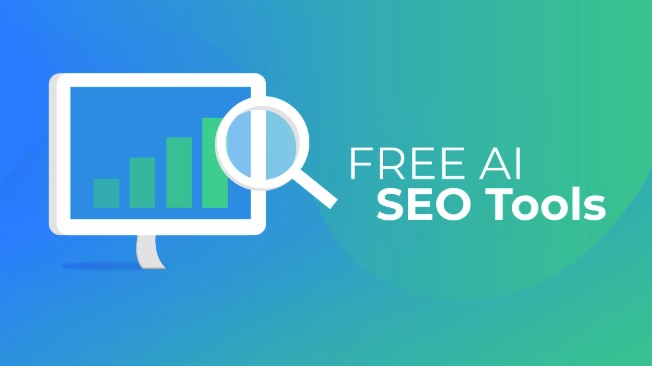Table of Contents
As I explore the world of digital marketing, I often find that using the right tools can make a significant difference in search engine optimization (SEO). The best free AI SEO tools can help streamline your efforts, making it easier to boost your website’s visibility without emptying your wallet. With so many options available, it’s essential to focus on tools that not only enhance your SEO strategy but are also easy to use.

In this article, I will share some of the best free AI SEO tools that I’ve come across. These tools can assist with keyword research, site audits, and content optimization, all crucial elements for improving your online presence. Whether you are a beginner or have some experience in SEO, these resources are valuable for anyone looking to enhance their website’s performance.
Overview of AI in SEO

AI is changing how I approach search engine optimization. By automating tasks and providing insights, AI helps to improve the effectiveness of my SEO strategies.
Role of AI in Modern SEO
In today’s digital landscape, AI plays a crucial role in SEO. It assists in data analysis, which helps me understand user behavior and preferences more clearly.
AI tools can process vast amounts of data quickly, identifying trends that I might miss. This allows me to adjust my strategies based on real-time insights.
Furthermore, AI helps with keyword research. It analyzes search patterns and suggests keywords that can enhance my content’s visibility on search engines.
Using AI-driven tools means I can optimize titles, meta descriptions, and other on-page elements more effectively. These tools not only save time but also ensure a finer-tailored approach to content creation.
How AI Can Enhance SEO Strategies
AI enhances my SEO strategies in several key areas. First, I rely on AI for content creation. It generates ideas and even drafts content based on trending topics and SEO best practices.
AI-powered tools can also assist with technical SEO. They monitor website performance, identifying issues like slow page load times or broken links, which can negatively impact rankings.
Another advantage is personalized user experiences. AI enables me to customize content for different segments of my audience, making it more engaging and relevant.
I can also utilize AI for competitive analysis. These tools provide insights into competitors’ strategies, helping me stay ahead in the competitive SEO landscape.
Employing AI effectively boosts my SEO outcomes by making my efforts more efficient and allowing me to focus on strategic decision-making.
Keyword Research Tools
In my quest for the best free AI SEO tools, I’ve found that effective keyword research is essential for driving traffic. These tools help me identify trending topics and analyze search volume and competition.
Identifying Trending Topics
To start, I focus on identifying trending topics relevant to my audience. Tools like Google’s Trend Reports or social media insights help me discover what people are currently interested in.
I look for keywords that show a rise in search inquiries. This not only captures attention but also positions my content in front of an engaged audience.
I also leverage platforms that suggest keywords based on popular searches. By utilizing these insights, I can tailor my content to meet current demands.
Analyzing Search Volume and Competition
Once I have a list of potential keywords, I analyze their search volume and competition. This step is crucial for pinpointing which keywords are worth pursuing.
I often use tools like Ubersuggest to see how frequently a keyword is searched. I pay attention to both high-volume keywords and those with lower competition.
This balance allows me to target terms that can drive traffic without being lost among big players. A clear understanding of these metrics lets me craft informed and strategic content that resonates with my audience.
Content Optimization Tools

Using AI can greatly enhance how I optimize content for better performance. There are specific tools designed to improve content quality and on-page SEO, ensuring that I meet both user needs and search engine requirements.
Enhancing Content Quality with AI
AI tools help me improve the quality of the content I produce. These tools analyze existing content to suggest improvements in clarity, grammar, and engagement. For instance, I might use an AI writing assistant that offers real-time feedback. This includes grammar corrections and style suggestions.
Additionally, some tools provide insights into the tone and readability of my text. By checking these factors, I can tailor my writing to better resonate with readers. Tools like these often use algorithms to assess how well the content aligns with target audiences. This ensures that my content is both engaging and informative.
Improving On-Page SEO
On-page SEO is crucial for my content’s visibility. AI tools can help identify the best keywords to include in my articles. I often use keyword research tools to find relevant phrases that potential readers are searching for.
Also, some tools analyze my page structure, including headings and images. This helps me ensure that I use keywords effectively throughout the content. A strong focus on meta descriptions and title tags can also enhance my content’s search engine ranking.
Using these tools, I can effectively optimize title tags and descriptions, resulting in higher click-through rates. By continuously checking and improving these elements, my content has a better chance of performing well in search engine results.
Technical SEO Auditors
I find that technical SEO auditors play a crucial role in optimizing website performance. These tools help identify site health and performance issues and pinpoint specific technical problems that can affect search engine rankings.
Site Health and Performance
Monitoring site health is essential for maintaining strong SEO. I use various free AI tools to assess page speed, mobile-friendliness, and overall performance. For instance, Google PageSpeed Insights provides a clear evaluation of these factors, giving a score and actionable suggestions for improvement.
Another useful tool is SE Ranking, which offers detailed insights into technical elements like page load times and server response errors. By regularly checking these metrics, I can ensure my site delivers an excellent user experience, which is critical for SEO success.
Identifying Technical Issues
Identifying technical issues is another key function of these tools. Issues like broken links, duplicate content, and incorrect redirects can harm rankings. Using tools such as Ahrefs allows me to run comprehensive audits that highlight these problems.
For instance, SEMrush has a feature that provides a checklist for fixing critical issues. Features like these streamline the process for me. I can quickly prioritize which fixes to tackle first. By resolving these technical challenges, I improve my site’s search visibility and provide better content for users.
Backlink Analysis Tools
Analyzing and monitoring backlinks is essential for improving SEO. It helps identify valuable links and recognizes potentially harmful ones. Here are key aspects of backlink analysis that can significantly impact your website’s performance.
Monitoring Backlink Profiles
I find that monitoring backlink profiles allows me to keep track of where my website stands in search engine rankings. Using tools like Free Backlink Checker, I can easily see which sites link to mine and how many backlinks I have.
This information lets me discover new opportunities for partnerships and collaborations. I regularly check for any lost backlinks as they can affect my site’s authority. If I notice any significant changes in my backlink profile, I can investigate and address issues quickly.
Additionally, I can set up alerts to notify me of new backlinks, which helps me stay proactive. This practice ensures I maintain a healthy backlink profile.
Evaluating Link Quality
When I evaluate link quality, I focus on the authority and relevance of each backlink. High-quality backlinks come from reputable sites in my niche. Tools like Neil Patel’s Backlink Analysis can provide insights into the quality of backlinks.
I assess metrics such as Domain Authority (DA) and Page Authority (PA) to judge a link’s strength. Backlinks from domains with high DA add more value than links from low-authority sites.
In my process, I also look for links with good anchor text. Relevant anchor text can improve my site’s rankings for specific keywords. I make it a point to regularly analyze the quality of my backlinks to strengthen my overall SEO strategy.
Rank Tracking Solutions

Effective rank tracking is essential for monitoring your website’s performance in search engine results. I will explore two key aspects: tracking SERP positions and competitive analysis. Both provide insights essential for improving SEO strategies.
Tracking SERP Positions
Tracking SERP (Search Engine Results Page) positions helps me see where my website ranks for specific keywords. I can use tools that provide daily or weekly updates, so I stay informed about any changes.
Some popular options include:
- Google Search Console: Free and reliable, offering insights into organic search performance.
- Ubersuggest: Provides keyword tracking with a user-friendly interface.
- Zutrix: An AI-powered tool that offers real-time rank updates and smart notifications.
These tools help me focus on keywords that drive traffic, allowing me to adjust my SEO efforts based on performance.
Competitive Analysis
Competitive analysis is vital for understanding my position in the market. By analyzing competitors’ rankings, I identify gaps in my strategy. Tools like Ahrefs and SEMrush offer powerful features for this.
I can examine:
- Competitor Keywords: See which keywords my competitors rank for but I do not.
- Backlink Profiles: Understand where their backlinks come from, revealing potential linking opportunities.
- Content Performance: Analyze what kind of content performs best in my niche.
This information allows me to refine my approach, target high-value keywords, and develop better content strategies. By keeping track of my competition, I improve my chances of climbing the rankings.
AI Content Generation
AI content generation has transformed how I create and manage content. These tools automate the writing process and enhance the scalability of my content production. Here, I focus on two crucial aspects: automated content creation and how these tools allow for content scalability.
Automated Content Creation
With automated content creation, I can quickly generate text based on specific prompts. Tools like Jasper, Rytr, and Writesonic allow me to produce articles, blog posts, and other content types efficiently.
Using these AI tools, I input keywords or topics and receive coherent text back in seconds. This process minimizes writer’s block and helps me maintain a steady flow of content. Many platforms also offer features like SEO optimization, ensuring my content ranks well in search engines.
The ability to draft and edit content rapidly means I can focus on refining ideas rather than getting stuck in the writing process.
Content Scalability with AI Tools
AI content generation enables me to scale my content creation efforts significantly. With these tools, I can produce a large volume of content across various formats quickly.
For example, if I manage multiple blogs or social media accounts, I can use AI to generate tailored content for each platform. This level of efficiency means I can meet tight deadlines without sacrificing quality.
Furthermore, AI tools often include content planning and scheduling features. This makes it easier for me to plan a content calendar and ensure timely publication. By utilizing AI, I can expand my content reach and keep my audience engaged with consistent updates.
User Experience Enhancements
Improving user experience (UX) is crucial for retaining visitors and boosting engagement on a website. I focus on two key areas: optimizing for UX signals and improving user engagement. Each plays an essential role in how users interact with content and navigate through a site.
Optimizing for UX Signals
I pay close attention to key user experience signals like page load speed, mobile responsiveness, and content structure. Tools like Google PageSpeed Insights help me analyze the performance of my website. They provide actionable insights on how to reduce loading times and improve overall performance.
Mobile responsiveness ensures that my content is accessible on various devices. A responsive design helps avoid high bounce rates, as users can easily navigate the site. Additionally, proper layout and spacing keep my content organized, allowing for an enjoyable reading experience.
Improving User Engagement
I utilize AI tools that analyze user behavior to enhance engagement. These tools provide insights into what content resonates with my audience. By studying metrics like time spent on pages and click-through rates, I can identify popular topics and formats.
Incorporating engaging visuals, informative videos, and interactive elements keeps visitors interested. I also focus on crafting compelling headlines and clear calls to action. Providing quality content that meets user needs encourages repeated visits and shares.
Voice Search Optimization
Voice search is becoming increasingly important in SEO. I need to adjust my strategies to meet the growing trend. This section explores how to prepare for voice search trends and optimize content for conversational queries.
Preparing for Voice Search Trends
To successfully adapt to voice search, I focus on several key aspects. First, I perform thorough keyword research. I identify natural language phrases and questions that users might speak.
Next, I ensure my website is mobile-friendly. Most voice searches occur on mobile devices, so a responsive design helps.
I also optimize my local SEO efforts. Many voice searches include local intent, like “near me” queries. Claiming my business on platforms like Google My Business can improve visibility.
Lastly, I consider using structured data markup. This helps search engines understand my content better, making it more likely to appear in voice search results.
Optimizing for Conversational Queries
For conversational queries, I adopt a different writing style. I aim to create content that sounds natural when read aloud. Short, clear sentences work best.
I also answer common questions directly. Using FAQs on my website can enhance this approach. I focus on questions with local and specific relevance.
Including conversational keywords is vital. Phrases like “what is,” “how to,” and “where to find” should be prevalent.
I ensure my content provides quick, concise answers. This increases the chance of being featured in voice search results.
By aligning my content with how people naturally speak, I significantly enhance my chances of success in voice search optimization.
Local SEO Boosters
I know that local SEO is essential for businesses wanting to attract customers in their area. I will explore how to enhance search visibility and manage local listings effectively.
Enhancing Local Search Visibility
I use various tools to boost local search visibility. These tools help analyze specific local keywords, allowing me to optimize my website accordingly.
I focus on the following key strategies:
- Localized Content: I create content that speaks to my community, using local landmarks or events to draw in local traffic.
- Keyword Optimization: I incorporate local keywords into meta tags and descriptions for better search results.
- Customer Reviews: I encourage satisfied customers to leave reviews. Positive reviews can significantly impact local rankings.
By applying these practices, I improve my visibility in local search results, helping potential customers find my business easily.
Managing Local Listings with AI
I leverage AI tools to manage my local listings effectively. These tools simplify the process of keeping my business information accurate across various platforms.
Key benefits include:
- Automated Updates: I can automatically update my business information across multiple directories, ensuring consistency.
- Insights and Analytics: AI tools provide analytics about how customers interact with my listings. I use this data to make informed adjustments.
- Local SEO Insights: These tools often include features that analyze my business’s performance against competitors in the local area.
Utilizing AI for local listings allows me to stay competitive and reach more local customers effortlessly.
AI Analytics and Reporting

AI tools can significantly enhance how I analyze and report on SEO data. These tools make it easier to interpret complex information and automate reporting processes, which saves time and improves decision-making.
Interpreting SEO Data with AI
I find that AI analytics tools can simplify the process of interpreting SEO data. They use algorithms to analyze patterns in large datasets. This helps to identify trends that I might miss through manual analysis.
For example, I can quickly see which keywords drive the most traffic to my website and which ones may need optimization. Many tools, like Google Search Console, offer insights into click-through rates and page performance. With AI, I can receive predictive analytics that indicate how certain changes may impact future rankings. Using these insights allows me to make data-driven decisions.
Automated SEO Reporting
Automated SEO reporting is another area where AI tools excel. These tools can generate reports regularly without requiring my constant input. I appreciate how they compile key metrics into easy-to-read formats.
For instance, tools like SEMrush and Moz can create customized dashboards showing my site’s performance in real-time. They highlight important metrics such as traffic changes, keyword rankings, and backlink profiles. This automation saves time and ensures that I always have up-to-date information at my fingertips. The ability to schedule reports also means I can share results with my team efficiently.




